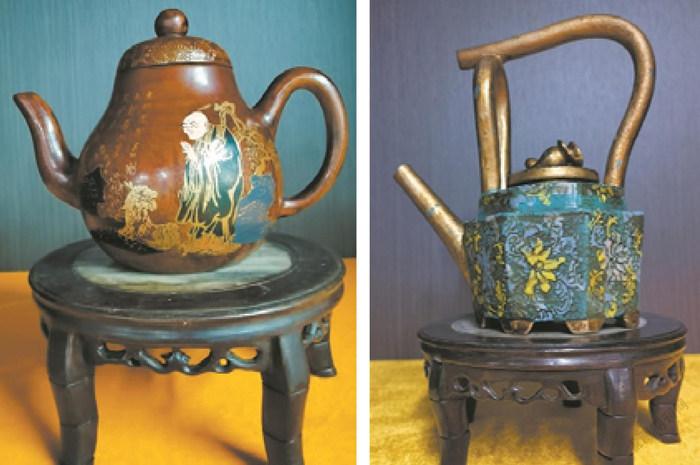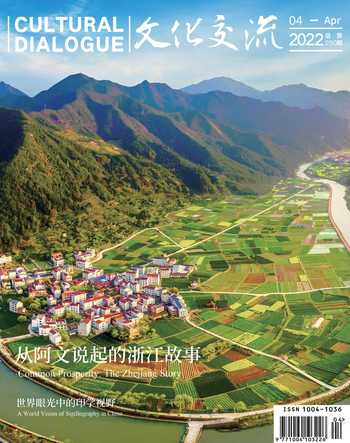让文物归国 让文化回家
程潇潇 应忠彭


自岁月深处走出的石佛像、由珍稀木材雕刻的大型根雕、古代宫廷御制的陶器和玉器,以及充满异域风格的牙雕、银器……时隔近五年,温籍收藏家黄加珍的仙庄文化艺术馆迁址温州经济技术开发区滨海园区,增地扩容,展出他收藏的2.3万余件文物及工艺美术品。
2016年,黄加珍在温州市瓯海区创办仙庄文化艺术馆,面积600平方米,如今,新展馆扩大至6000多平方米。“让中国厚重的传统文化艺术展现在大家眼前,希望通过展示促进人们对古文化的认识,达到沟通、交流和共享的目的。”二十多年前,黄加珍立志“尽可能多地让中国古文化器物回家”,从而走遍荷兰、比利时、法国、德国、意大利等欧洲国家大小城市的收藏圈及拍卖行,为家乡文化建设献上了一份厚礼。
创业维艰 收藏随缘
从事收藏,需要有相当的经济实力。黄加珍出生在温州瓯海郭溪的一个农民家庭,并不算富裕的家中,还有五个哥哥、一个姐姐和一个妹妹。“我的母亲是位伟大的母亲,她坚持供我们一大帮孩子上学直到高中毕业,大哥还考上了大学。”现已是花甲之年的黄加珍,忆述往事时脸上挂着乐呵呵的神情,配上一对极大的耳垂,与弥勒佛有几分神似,令人颇感亲切。上世纪八十年代末,当人们用“万元户”来形容家财万贯时,有着聪慧头脑的黄加珍已通过创办标准紧固件工厂,赚得百万身家。
在那个年代,做生意不易,树大招风,后来他因所谓的“投机倒把”,被罚没了名下企业户头上的两万元钱。时值“出国潮”在温州兴起,这件事让他下定决心于1991年告别家乡,去了阿根廷首都布宜诺斯艾利斯闯荡。在阿根廷,黄加珍从端盘子做起,逐渐适应当地生活,很快立稳脚跟。一次机缘巧合中,他成为当地的世界500强企业阿根廷尤尼特集团“坚木单宁”(一种皮革制品鞣剂)的中国总代理商,创办浙江尤尼特商务有限公司。
1995年,黄加珍因事务回国,闲暇时陪同一位从事收藏的朋友前往福建看木雕。在朋友熟门熟路的带领下,他来到一位木雕商贩家中,见一件红豆杉根雕十分合眼缘,想着“摆在家中,闻闻木香,有益健康”,便经一番讨价还价,以5万元价格入手了连同这件红豆杉根雕在内的五六件木雕作品。那几件木雕都是珍稀木材,有红豆杉、黄花梨木等。按照行规,有人讲价时竞争者不能出声。“当时我那位朋友也很想买,但他让我先讲价。我没什么经验,只凭喜欢也看不出好坏,讲定价格后也不知道是买赚了还是买亏了,直到走出那个门,朋友冲我点头示意‘东西好得很’。”
当初5万元购入的第一批木雕收藏,此后几年里水涨船高,这次经历也让黄加珍发觉收藏一道实在“水深”。此后,以珍稀原料为基础的现代雕刻艺术品成为黄加珍主攻的收藏类别之一。如今其艺术馆内,陈列有高公博、田健桥、田健宝、潘成松、孙显秋等百余位工美大师的木雕、玉雕、石雕等作品。
坚守信念 文物“回家”
人生处处有际遇,收藏莫不如是。2000年,黃加珍通过技术移民,举家迁至荷兰定居。2005年4月,黄加珍从一位荷兰老翁口中得知,对方家中藏有一尊其父辈40年前在中国广西桂林购入的孔夫子像。黄加珍随老翁到他家中一看,笑了:“这哪里是孔子,分明是刘伯温啊!”那座铜像的官服官帽为明代制式,品相完好,黄加珍见到后当即动了收藏的念头,“刘基是温州文成人,被我碰到就是缘分,我得把他请回去”。于是,他每隔几天就敲响老翁家门,整整磨了3个月,恰巧老翁的夫人嫌弃铜像占用空间且十分碍事,老翁最终无奈忍痛割爱。黄加珍笑着告诉记者,这座以900欧元价格成交的铜像,后来还被好几个朋友“惦记”上了,其中一位姓刘的朋友是刘基后裔,曾表示愿意出价百万收购,可他拒绝了。“我做收藏一般都只收,不卖。”黄加珍把这当作对文物的一种敬意。
黄加珍的收藏中,以佛像最多。“明清时期,我国受荷兰海盗掳掠,大量文物流失海外。而荷兰约有百分之十五的家庭信奉佛教,家中常供奉有佛像。”如今仙庄文化艺术馆内,收藏有各类佛像,达一万余件,均是中国流失海外的珍贵文物。
一尊高1.2米,重量却仅有22公斤的泥胎夹纻佛像,是艺术馆的镇馆之宝。黄加珍最初在拍卖行见到这尊佛像时,还以为是玻璃钢材质,后来才得知,泥胎夹纻,是古老的中国传统手工技艺。泥胎夹纻佛像,是在泥塑成胎后用漆把麻布贴在泥胎外层,待漆干后把泥胎取空,塑像质地轻盈且柔和逼真。由于制作工艺复杂,所耗材料昂贵且成功率低,所以历史上没有大型的夹纻干漆造像,大多夹纻佛像都流往国外,而今美国大都会博物馆和西雅图博物馆都藏有唐代夹纻干漆佛像。从此,黄加珍尝到了捡“漏”滋味,开始把大把时间花在拍卖网上。
随着在荷兰收藏圈中的名气越来越大,黄加珍能接触到各类流失海外“国宝”的机会也越来越多。每当遇到有价值的中国文物,他总是尽力将其纳入收藏,希望有一天能够让文物“回家”。
传统文化 传承共享
黄加珍的收藏中,有从中国流出去的各朝代佛像和古代青铜器、紫砂、陶瓷和文房等,包括张之洞砚台、吴之潘等大师的竹雕藏品、清凉寺镶金汝窑渣斗和易定款梅瓶以及真子飞霜青铜镜等高级藏品,也有19世纪中国和欧洲象牙雕刻等。
如何让流失国外的文物回家?黄加珍多次乘坐国际航班往返,成为荷兰皇家航空公司VIP客户。凭借VIP身份,他把文物装在每次飞行仅能随身携带的两只行李箱中运回,许多大件行李不能携带,则采用航空托运的方式。多年间,他采取“蚂蚁搬家”的方式,让两万余件流失海外的文物和艺术品顺利归国。
“运回国的宝物,就再也出不了国了。”黄加珍说,“这些文物和艺术品都是无价的,回来了便不会再流出国”。2017年1月,黄加珍腾出600平方米位于瓯海的厂房,创办了温州市仙庄文化艺术馆,成为“温州市侨务文化基地”,首次展出了60余件中国古佛像和680余件中国不同朝代器物。而今,迁入新址的文化艺术馆面积扩大了10倍,藏品丰富不输一些公有收藏机构,是浙江罕见的民办中国古文化器物专题艺术馆,并面向社会免费接受团队预约参观。黄加珍说,若有机会还想创办一家真正的博物馆,让文物“活”起来,让更多人透过这些归国文物共享中国传统文化。
Ancient stone Buddha sculptures, rare root sculptures, imperial potteries and jade wares, exotic ivory carvings and silver wares, all could be found in Xianzhuang Culture and Art Gallery owned by Huang Jiazhen, a Wenzhounese collector. After a five-year expansion, the gallery is now relocated at Binhai Park in Wenzhou Economic and Technological Development Zone, displaying more than 23,000 cultural relics, arts and crafts.
In 2016, Huang Jiazhen opened his gallery in Ouhai district, Wenzhou city with an area of only 600 square meters; today, the new gallery occupies over 6,000 square meters. He hopes that his collection could broaden people’s knowledge of ancient Chinese culture through better communication and sharing.
More than 20 years ago, Huang was so determined to retrieve Chinese cultural relics overseas that he went to all kinds of auctions in Europe. He set foot on many countries including the Netherlands, Belgium, France, Germany and Italy. His endeavors have proved to be a great contribution to cultural development in China.
Huang was born into an ordinary peasant family in Wenzhou, Zhejiang, with five brothers and two sisters. “My mother was a great mom, doing all she could to support our education all the way to high school and my big brother was even a college student,” Huang smiled when all the memories flashed back. Aged in his sixties with his big round earlobes, Huang looked quite like the Laughing Buddha, cordial and comfortable. In the late 1980s, when wealthy families were called “ten-thousand-yuan households”, Huang had already become a millionaire, managing a standard factory of fasteners.
It was not easy to do business in that era, large enterprises in particular. After he was fined 20,000 yuan due to “speculation and profiteering”, Huang decided to say goodbye to his hometown in 1991. He went to Buenos Aires, and started from scratch as a waiter. Later, an opportunity made him the exclusive distributor in China of Unitan Group, a Global 500 company in Argentina. Huang then established Zhejiang Unitan Business Co., Ltd. in China.
In 1995, on his business trip to China, his collector friend took him to a wood carving trader’s home in Fujian province. Huang took a fancy of a taxus chinensis root sculpture. Thinking that wood smell did good to one’s health, Huang bargained and purchased it together with other wood carving items for 50,000 yuan. All those items were made of rare wood like taxus chinensis and Chinese rosewood. According to the trading practice, potential buyers should keep silent when other buyers were bargaining. “My friend also liked the taxus chinensis sculpture, but he let me propose the price first. I didn’t have any experience and was so not confident of the price. Luckily, my friend nodded to me when we left there, meaning those crafts were of high quality and value,” Huang explained.
A few years later, the price of Huang’s first collection skyrocketed and this successful experience triggered Huang’s interest in collecting. Modern carving artifacts of rare materials became one of Huang’s main collection types. Today, a great number of wood sculptures, jade sculptures and stone sculptures are exhibited in his gallery. They are created by hundreds of well-known artists such as Gao Gongbo, Tian Jianqiao, Tian Jianbao, Pan Chengsong and Sun Xianqiu.
Life is full of opportunities and collecting is no different. Huang Jiazhen and his family immigrated to the Netherlands in 2000. In April 2005, an old Dutchman told Huang that he had a statue of Confucius which was purchased by his father 40 years ago from Guilin city in Guangxi Zhuang autonomous region. Huang went over to his home and laughed when he saw the statue, “This is not Confucius. This is obviously Liu Bowen!” With the hat and uniform of the copper statue, it was clearly a Ming dynasty (1368-1644) product in a very good condition. Huang made up his mind to collect it right after he saw it. He said, “Liu Bowen was a renowned prime minister in the Ming dynasty and he was a Wenzhounese too. It is such an amazing opportunity that I encountered the statue here. I have to bring it back.” He then kept going to the Dutchman’s house every few days, trying to persuade him. Three months later, the old man finally gave up and sold it for 900 euros. Huang smiled and said that many of his friends wanted to buy the statue later on, one of them being a descendant of Liu himself. “He would like to have it for a million, but I rejected. My collection is basically not for sale.” Huang considers this as a way of showing respect to cultural relics.
Huang’s collections are mostly Buddha statues. He says, “In the Ming and Qing dynasties, a large number of Chinese cultural relics were robbed by Dutch pirates. About 15 percent of Netherlanders believe in Buddhism and they often have Buddha statues in their home.” In Huang’s gallery, there are currently more than 10,000 Buddha statues, all of which retrieved from overseas.
A 1.2-meter high ramee-lacquer statue only 22 kg in weight is the most treasured piece in Huang’s gallery. When he first saw this statue in an auction, he thought it was mere fiberglass. But he got to know later that it was made with an ancient Chinese hand-made technique called “ramee lacquer”. The shape of the statue was originally formed using simple clay, and then it was covered with a thin layer of ramee stripes and firmed up with paint. After the paint dried out, the inner clay was hand removed cautiously until it was completely hollow inside. This unique technique made the statue not only light but also extremely lifelike. Due to complicated techniques, expensive materials and low success rate, large ramee lacquer statues are seldom seen now and most of them are not in China. There are several Tang ramee lacquer Buddha statues in Metropolitan Museum of Art and Seattle Art Museum in the US.
As his reputation rose in the Dutch collection circles, Huang had more chance to find “national treasures” lost abroad. Every time he encountered valuable pieces, he would try his best to purchase them, hoping that some day those treasures could go back home.
It is no exaggeration to say that Huang’s collection includes almost everything. There are Buddha statues of different dynasties, ancient bronze wares, boccaro, potteries and the Four Treasures of Study (brush, ink, inkstone and paper). Zhang Zhidong’s inkstone, Wu Zhipan’s bamboo sculptures, gold inlaid Ru Kiln buckets from the Qingliang Temple, plum vases marked with the title “Yingding”, bronze mirrors engraved with the titles “Zhenzi” and “Feishuang”, as well as other Chinese and European ivory carvings of the 19th century.
How did he bring back lost historical relics overseas? As a VIP member of the KLM Royal Dutch Airlines, Huang managed to bring them back by carry-on luggage. In this way, he has shipped back more than 20,000 pieces of relics and artifacts over the years.
“These returned relics are priceless and they should not be taken abroad again,” Huang said. In January 2017, Huang established Xianzhuang Culture and Art Gallery in his 600-square-meter factory in Ouhai. There were 60-odd ancient Buddha statues and 680 artifacts from different dynasties in its first exhibition. The gallery then became the cultural base for overseas Chinese affairs in Wenzhou. Now, the relocated gallery is ten times bigger and the collection itself is so diverse that it can rival those in public institutions. It is a rare private antique art gallery in Zhejiang, open to public group tours for free. Huang hoped that he would like to build a real museum, if possible, in the future to make his collection come into “life” and to attract more people to get to know and understand traditional Chinese culture.

